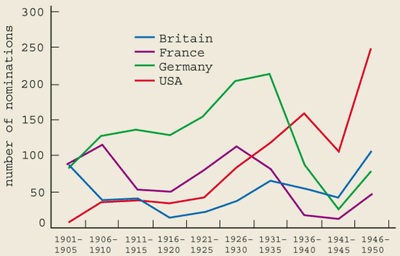Nobel
population 1901-50: anatomy of a scientific elite
Feature: November 2001 Next month sees the centenary of the award of the
first Nobel prizes. But how representative are the physics Nobel laureates
of the international physics community?
Candidates between 1901 and 1950 also came from a very narrow range of countries. Of the 2416 nominations in physics, three-quarters were for scientists from only four nations: Germany (25%), the US (21%), France (16%) and Britain (13%). Germany in particular did very well early on (see figure). The rest were mainly distributed among other European countries, notably Scandinavia, eastern Europe, the Netherlands and Italy. Candidates from other continents - Latin America (Peru and Brazil) or Asia (India and Japan) - accounted for less than 2% of nominations. Africa was completely absent from the Nobel map.
The vast majority of nominations in physics (67%) were for candidates based in university teaching departments and laboratories. The second largest group of nominees (10%) worked in institutes of technology - anything from technical schools to universities of technology. A few nominees worked in independent research institutes and government labs, such as James Dewar of the Royal Institution in London and Friedrich Kohlrausch of the German Bureau of Standards, although neither won a prize. Industrial physicists were also few and far between. Guglielmo Marconi, who shared the 1909 physics prize for his development of wireless telegraphy, was a rare example. The rest of the nominees included physicists such as Oliver Heaviside and William Crookes who had "no affiliation" and worked in laboratories that they had set up at home - a practice that was not uncommon at the start of the 20th century.
Germany's rise and fall
At the start of the 20th century, most physicists who were nominated for a Nobel prize came from just four nations: Britain, France, Germany and the US.
However, after Hitler came to power in 1933, he passed a law that prohibited German citizens from receiving a Nobel prize. This led to a sharp decline in the number of nominations for German physicists, with the few that remained coming from outside Germany. The data also reveal the spectacular growth of the US as a scientific power.
[Special note: The sudden drop for all the countries is due to World War II, and the prize is suspended for several years.]
